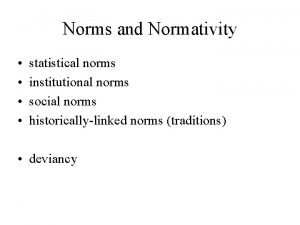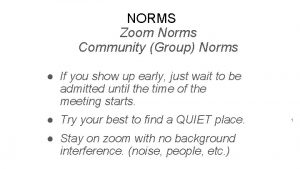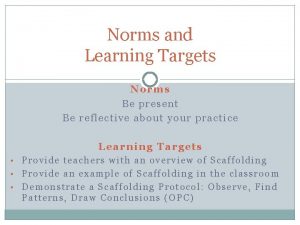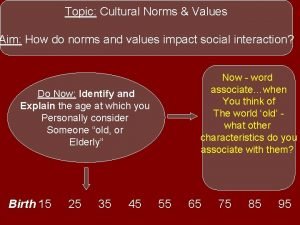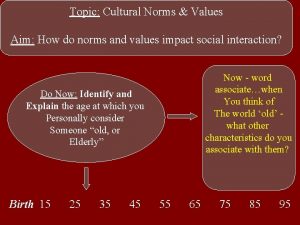Social Norms Social norms consist of rules of

















- Slides: 17

Social Norms Social norms consist of rules of conduct and models of behavior prescribed by a society. Social norms are codes of conduct that are considered “normal” by any particular culture.

What is “Normal? ” l How do we know what is “Normal”? l Who determines what is “Normal”? l Do we always agree on what is “Normal”?










Film Clip

Take the Elevator! Imagine that you are in an elevator in a hotel in the United States. All of the other occupants are unknown to you. Read answer the questions and discuss them in your groups. l l l What are the rules are for standing in the elevator? Where do people stand when there are only two or three people? What happens when a fourth person enters the elevator. How would you feel if there were two people on the elevator and a third person entered and stood right next to you? What happens when the elevator becomes more crowded and there are now four or more people? How close will people stand? What is allowed to "touch? " What do people look at in a crowded elevator? When is it permissible to talk to the other people?

Elevator behavior in the United States is very rigid. Compare your responses with those below. l 1. If there are only two or three people on an elevator, each person usually leans against the walls. If a fourth person boards the elevator, the four corners are normally occupied. l 2. This would be a breach of our personal “space. ” We would feel very uncomfortable and move or get off the elevator at the next stop. l 3. When there are more than four people on an elevator, the occupants begin to follow a complex set of rules for behavior. Everyone turns to face the door. Hands, purses, and briefcases hang down in front of the body. People usually scrunch up, rounding their shoulders, so that they take up as little space as possible. l 4. People don’t touch each other in any way unless the elevator becomes very crowded, and then they only touch at the shoulders or upper arms. If you see an overcrowded elevator, you will probably choose to wait for the next one. l 5. Everyone usually looks at the floor indicator located above the door. l 6. It is unusual for people (who are strangers) to speak to each other in an elevator unless they are sharing some kind of similar experience. (Such as a conference) People who do know each other will usually speak softly. When a group of people enter the elevator and do not follow these rules, other occupants usually feel very uncomfortable.

Rules for Personal Space in the U. S. Proxemics is the study of the rules in a culture about space. How far away to people stand during different types of conversations? Have you ever heard of the American "bubble? " Most Americans feel most comfortable when people keep an arms-length away during conversations. Personal distance, which is the space between colleagues during a normal conversation, is usually about 20 to 36 inches. If the person is not well known to us, we will stand from 2 to 4 feet away during a conversation. l The rules of space proxemics are well defined in all cultures. These attitudes about space are very hard to change. They also offer an opportunity to demonstrate how culture affects our behavior. l


l You need to purposefully break a social norm and record the reaction of others. l You can do this individually, in pairs, or small groups. l Brainstorm ideas, write one down, get it approved by Rother.
 Great britain countries
Great britain countries Great britain consist of
Great britain consist of What does the united kingdom consist of
What does the united kingdom consist of Safety net drop tests must consist of a
Safety net drop tests must consist of a Microemulsion definition
Microemulsion definition Composition of blood
Composition of blood Accessible wiring
Accessible wiring What does britain consist of
What does britain consist of Loader and linker
Loader and linker Servlet runs each request in a mcq
Servlet runs each request in a mcq Problem analysis chart examples
Problem analysis chart examples Primary villi consist of
Primary villi consist of What does an ict system consist of
What does an ict system consist of Jingles are musical written around the brand
Jingles are musical written around the brand Refresh crt consist of
Refresh crt consist of Direct material cost
Direct material cost Gear applications
Gear applications Diphthongs consist of
Diphthongs consist of


















